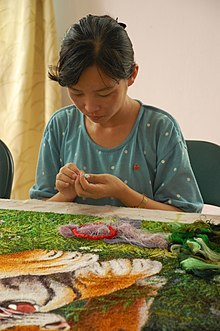 | |
| General Statistics | |
|---|---|
| Maternal mortality (per 100,000) | 82[1] |
| Women in parliament | 16.3%[2] |
| Women in labour force | 47.813%[3] |
| Gender Inequality Index | |
| Value | N/A |
| Part of a series on |
| Women in society |
|---|
 |
The status of women in North Korea is not fully understood outside the country, due to the political isolation of North Korea, the unwillingness of the North Korean authorities to allow foreign investigators access in the country, and the existence of conflicting reports.[citation needed] The official position of the North Korean government is that women have equal rights with men.[4]
North Korea has enacted laws such as the Law on Sex Equality, the Labor Law, and the Law on Nationalization of Essential Industries. Although these social systems have not entirely been successful, they have been integrated into daily life to help women. The reforms implemented provided women's rights at work, rights of inheriting and sharing of properties, and rights of free marriage and divorce. North Korea also outlawed polygamy. The state confiscated all privately owned land, in theory eliminating property discrimination. Today, women in North Korea participate in a variety of labor forces, and there is a considerable number of women who are in high positions. Also, there are many facilities for women including sanatoria, rest homes, and maternity hospitals.
The ratio of women to men in high wage jobs is considerably lower than that of low wage jobs.[citation needed] In addition, most women in high positions in society are either relatives or wives of top leaders.[citation needed] Jon Halliday has argued that the political atmosphere is an example of the same patriarchal structure that feminist reforms intended to dissolve. This demonstrates the degree to which Neo-Confucian ideals still permeate and affect social and political policies. North Korea has not followed China, Laos, Cambodia and Vietnam in their campaigns against Confucianism.[5]
- ^ "Maternal mortality ratio (modeled estimate, per 100,000 live births)". The World Bank. 2015. Retrieved 30 July 2017.
- ^ "Women in national parliaments". Inter-Parliamentary Union. 1 July 2017. Retrieved 30 July 2017.
- ^ "Labor force, female (% of total labor force)". The World Bank. 2016. Retrieved 30 July 2017.
- ^ "Section 6. Discrimination, Societal Abuses, and Trafficking in Persons". Korea, Democratic People's Republic of (Report). Country Reports on Human Rights Practices for 2015. Bureau of Democracy, Human Rights and Labor. 2015.
- ^ Halliday, Jon. "Women in North Korea: an Interview with the Korean Democratic Women's Union Journal." Bulletin of Concerned Asian Scholars 17 (1985): 46–47. Print.